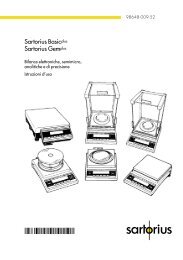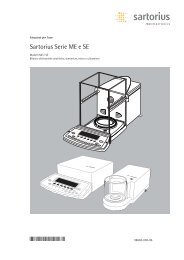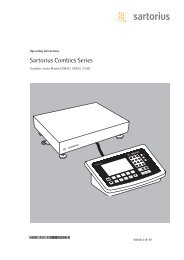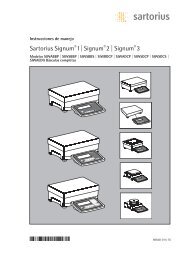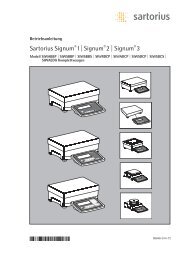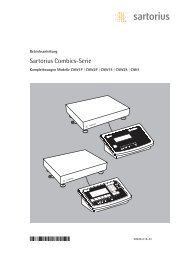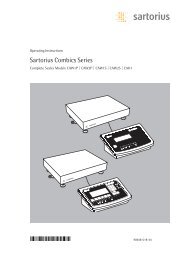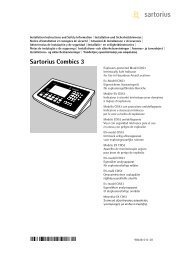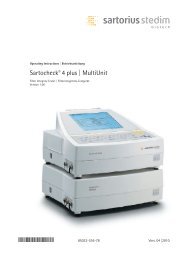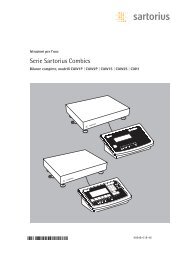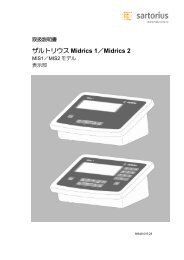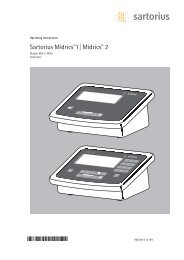Appl Sartobind Endotoxin Removal SL-4040-e
Appl Sartobind Endotoxin Removal SL-4040-e
Appl Sartobind Endotoxin Removal SL-4040-e
You also want an ePaper? Increase the reach of your titles
YUMPU automatically turns print PDFs into web optimized ePapers that Google loves.
<strong>Appl</strong>ication Note<br />
<strong>Endotoxin</strong> <strong>Removal</strong><br />
Ion Exchange Chromatography with <strong>Sartobind</strong> ® Membrane Adsorbers<br />
Introduction<br />
<strong>Endotoxin</strong>s (lipopolysaccharides from<br />
membranes of gram negative bacteria) make<br />
up the majority of pyrogens, which must<br />
be removed from pharmaceutical products,<br />
biologicals for injection and some media<br />
for tissue cultures. There are many factors<br />
to be considered when designing a depyrogenation<br />
scheme for media or solutions<br />
containing proteins and peptides: type of<br />
target substance, proteins or peptides,<br />
product concentration, molecular weight and<br />
isoelectric point (pI); electrolyte concentration;<br />
pH and buffer system; and interactions such<br />
as interference or aggregation. In general,<br />
these factors determine a method for an<br />
effective pyrogen removal.<br />
Figure 1<br />
Structure of endotoxin aggregates in<br />
aqueous solutions of different composition.<br />
(Courtesy of Prof. F.B. Anspach, Hamburg<br />
University of <strong>Appl</strong>ied Sciences, Department<br />
of Natural Science Technology)<br />
Fig. 1 shows that endotoxin monomers in<br />
solution range from molecular weight of 4<br />
to 20 kDa but they can form micelles and<br />
vesicles with diameters up to 0.1 μm. The<br />
presence of detergents, chelators and proteins<br />
promotes the formation of structures<br />
like micelles (300-1000 kDa) and monomers<br />
(10-20 kDa), while bivalent ions promote the<br />
formation of large structures like vesicles<br />
(>1000 kDa) 1. If the target substance in<br />
the solution to be depyrogenated has a<br />
small molecular weight (e.g. buffer, salt,<br />
nucleotides, amino acids, peptides, some<br />
carbohydrates etc.) the endotoxins can be<br />
separated from the target substance by<br />
ultrafiltration with an appropriate cut off<br />
crossflow filter. However, proteins in the<br />
same molecular weight range as endotoxins<br />
cannot be separated by ultrafiltration.<br />
Due to the negatively charged phosphoryl and<br />
carboxl groups in endotoxins, ion exchange<br />
chromatography is the most common depyrogenation<br />
method for proteins; however,<br />
it has several drawbacks which limit its usefulness<br />
as depyrogenation step. This includes<br />
handling and usage problems such as packing,<br />
channeling, low flow rates, long regeneration<br />
times, compressibility and limited chemical<br />
stability. Small flow rates and susceptibility<br />
to fouling mean that incorporating chromatography<br />
resins into process scale purification<br />
steps can be expensive and troublesome.<br />
Sartorius has introduced a high capacity,<br />
scaleable and ready-to-use ion exchange<br />
membrane technology, which provides excellent<br />
performance needed for depyrogenation<br />
in the laboratory or for process scale.<br />
Detergents, EDTA,<br />
bile acids<br />
Mr (Monomer): 10-20 kDa<br />
Hydrophilic sites<br />
Bivalent<br />
cations<br />
Detergents<br />
(Proteins)<br />
Three standard strategies are available for<br />
removal of endotoxin from solutions with<br />
<strong>Sartobind</strong> devices. Using the strong basic<br />
ion exchanger type Q and a buffer pH lower<br />
than the pl of the protein, endotoxin will<br />
be bound and protein will pass through the<br />
membrane (negative chromatography).<br />
<strong>Sartobind</strong> STIC PA is an anion exchanger and<br />
works at the same pH conditons as Q but is<br />
also applicable at higher salt concentrations.<br />
When other contaminants such as host cell<br />
proteins have to bound at up to 20 mS/cm,<br />
<strong>Sartobind</strong> STIC (Salt Tolerant Interaction<br />
Chromatography) may be the membrane of<br />
choice as these contaminants can be effectively<br />
removed at such conditions. Using the<br />
strongly acidic ion exchanger type S and a<br />
buffer pH lower than the pl of the protein,<br />
the endotoxin will pass through and the protein<br />
will bind and can be subsequently eluted.<br />
Larger volumes for production scale (gram –<br />
kilogram) can be processed with <strong>Sartobind</strong> Q<br />
or STIC disposable capsules with 4 mm bed<br />
height. <strong>Sartobind</strong> Q capsules with 8 mm bed<br />
height may be applied as well.<br />
The reduction of endotoxin is expressed<br />
with a log reduction value (LRV) which is the<br />
logarithmic quotient (log10) of the sample<br />
solution containing the endotoxins, divided<br />
by the concentration of endotoxins of the<br />
filtered solution.<br />
LRV = log<br />
Micelles<br />
Mr: 300-1000 kDa<br />
EU/ml starting solution<br />
EU/ml filtrate<br />
Bivalent<br />
cations<br />
EDTA<br />
(Proteins)<br />
Lipophilic Sites<br />
Charged functional groups<br />
Bivalent cations (e.g. Ca 2+ , Mg 2+ )<br />
Vesicles<br />
Mr >1000 kDa
1. Purification of clinical vaccine proteins 2<br />
Purification of five recombinant bacterial vaccine<br />
proteins was investigated. The molecular<br />
weight range was between 35 and 53 kDa.<br />
Crude E. coli lysates were purified by a combination<br />
of anionic and cationic membranes.<br />
Membrane chromatography was able to<br />
reduce the purification process development<br />
time. Salt gradient elution was compared to<br />
pH elution on 15 and 100 cm 2 ion exchange<br />
membranes. The pH elution produced higher<br />
yields as well as eliminated the time necessary<br />
for desalting. In order to remove very high<br />
levels of DNA and endotoxins, two consecutive<br />
anionic exchanger (Q) steps were utilized.<br />
The first Q membrane was used as a product<br />
capture step, while the second Q was a negative<br />
chromatography step. The pH condition<br />
were optimized in order to let the product run<br />
through the second Q and directly captured<br />
on a cationic exchanger membrane (C).<br />
Membrane chromatography steps for a<br />
vaccine protein-D purification<br />
1. Adsorption and elution from Q<br />
– Bind at pH 8.0<br />
– Wash with 50 mM NaCl at pH 6.5<br />
– Elute with 100 mM NaCl at pH 4.7<br />
2. Flow through Q and loading of C<br />
– Load onto Q and C in series at pH 4.7<br />
– The protein flows through Q and binds to C<br />
– Disconnect Q from C membrane<br />
3. Elution from C<br />
– Elute at pH 5.5<br />
This purification method was adapted to<br />
purify four additional recombinant protein<br />
variants. All vaccine proteins were successfully<br />
scaled to 30 ml (1100 cm 2) <strong>Sartobind</strong><br />
disc membrane and 1.15 l (4 m 2) <strong>Sartobind</strong><br />
modules. The 1 liter (4 m 2) modules were<br />
run at a flow rate of 7 L/min/bar.<br />
Results<br />
Table 1: Clearance of endotoxin and DNA from protein-D<br />
Purification step <strong>Endotoxin</strong> LRV DNA LRV<br />
[EU/μg protein] [pg/μg protein]<br />
Sterile crude 6224 – 180 –<br />
After first Q 32 2 30 1<br />
After second Q/C 0.02 3 0.08 3<br />
Sterile filtration 0.002 1 0.05 –<br />
Total 6 4<br />
Table 2: Scale-up results with protein-B<br />
Scale Purity <strong>Endotoxin</strong> DNA<br />
[%] [EU/μg product] [pg/μg product]<br />
Q 100 2.8 ml (100 cm 2) 99.7 0.01 0.04<br />
Disc 30 ml (1100 cm 2) 98.2 0.002 0.10<br />
Module 1.15 l (4 m 2) 99.0 0.01 0.05<br />
1 liter ion exchange membrane = 3.64 m 2<br />
Discussion<br />
Process development experiments were evaluated by the ability to retain the target protein<br />
while removing endotoxins, DNA and contaminating proteins. <strong>Endotoxin</strong> removal was achieved<br />
by a 3 log removal in the first anion (Q) exchange step followed by an additional 3 log reduction<br />
in the second anion/cation (Q/C) step. DNA removal was accomplished by a 1 log reduction in<br />
the Q step followed by a 3 log reduction in the Q step. The process consistently gave purities of<br />
> 95 % and yield of 65 % of the target protein.<br />
One of the most important advantages using Membrane Adsorbers was the decreased processing<br />
time. Small-scale purifications would yield pure product in approximately 75 minutes. When<br />
scaled-up the processing time did not increase significantly, the entire chromatographic<br />
purification could be completed in a few hours. We took advantage of this quick equilibration<br />
time and built-in pH elution steps in nearly all of the recombinant proteins. The pH elution steps<br />
allowed the processing from one ion-exchange step to the next with only a pH adjustment.<br />
This eliminated the need for time consuming buffer exchange steps. Quick binding and pH<br />
elution is not possible in bead-based columns due to the long equilibration times required.<br />
The purification process was developed using <strong>Sartobind</strong> Q 100 (2.8 ml, 100 cm 2) and then scaled<br />
to 30 ml (1100 cm 2) disc and 1.15 l (4 m 2) <strong>Sartobind</strong> module (11- and 400-fold scale-up, respectively).<br />
Each of the scaled-up processes provided protein of equal purity and yields compared<br />
to the small-scale experiments. This data demonstrated that Membrane Adsorbers are easily<br />
scalable.<br />
A cleaning procedure was developed using 1 N NaOH and 1 N HCl on the anion exchangers<br />
and 1 N NaOH on the cation exchangers. Reproducibility and regeneration was demonstrated<br />
for 40 purification cycles by overlaying chromatograms.<br />
Conclusion<br />
The information gathered above demonstrated that Membrane Adsorbers are a valid option<br />
compared to the classical resin technology. The Adsorbers have proven to achieve a higher<br />
throughput and increased speed while maintaining the capacity, selectivity, and reproducibility<br />
required for industrial chromatographic separations. There was an overall reduction of labor as<br />
a result of no column packing, shorter set-up, and process times. Manufacturing capacity may<br />
quickly be expanded by simply adding more cycles.
2. <strong>Endotoxin</strong> clearance of a immunoglobulin<br />
solution with <strong>Sartobind</strong> Q 75<br />
Sample: Cytoglobin in 10 mM potassium<br />
phosphate, pH 6.0<br />
Device: one <strong>Sartobind</strong> Q 75<br />
Table 3 shows that endotoxin in a<br />
protein solution was removed effectively<br />
(99.40–99.97 %) with <strong>Sartobind</strong> Q 75.<br />
At the same time, the protein recovery<br />
was 84–86 %.<br />
3. Scale-up of endotoxin clearance from<br />
protease solution<br />
A. Clutterbuck 3 (Avecia Ltd., UK) successfully<br />
removed endotoxins and DNA from their<br />
GST-3C protease with <strong>Sartobind</strong> Q. He completed<br />
the process scale-up from <strong>Sartobind</strong> Q<br />
downscale units through pilot scale with 5”<br />
capsules for 100 L non-GMP demonstration<br />
batch to the final scale with 20” capsules for<br />
2 + 100 L cGMP production batches.<br />
Sample: GST-3C protease, 46 kD (genetically<br />
engineered fusion protein consisting<br />
of human rhinovirus 3C protease<br />
and GST, theoretical pI 6.8)<br />
Buffer: 50 mM Tris, 150 mM NaCl, 3 mM<br />
reduced glutathione, pH 8 at 20°C.<br />
Demonstration batch<br />
<strong>Endotoxin</strong> level of affinity column eluate:<br />
42,900 EU/ml<br />
Flowthrough after <strong>Sartobind</strong> Q was taken<br />
for endotoxin every 5 L (50 L total, initial<br />
100 L was reduced to the half before the<br />
endotoxin removal step).<br />
<strong>Endotoxin</strong> breakthrough was detected<br />
after 10 L, therefore, <strong>Sartobind</strong> Q 20”, 4 mm<br />
bed height (5 times larger membrane volume<br />
than 5”) was chosen for the final cGMP runs.<br />
Table 3: <strong>Endotoxin</strong> clearance of an immunoglobulin solution with <strong>Sartobind</strong> Q 75<br />
Endo- Sample Total Total LRV Endo- Protein Protein Protein Bound<br />
toxin volume endo- endo- toxin in in flow- in flow- protein<br />
concen- [ml] toxin toxin clear- sample through through [%]<br />
tration in in flow- ance [mg] [mg] [%]<br />
[EU/ml] sample through (%)<br />
[EU] [EU]<br />
1000 10 10000 60 2.2 99.40 5 4.2 84 16<br />
1000 10 10000 60 2.2 99.40 5 4.3 86 14<br />
Control (without protein)<br />
1000 10 10000 3 3.5 99.97 – – – –<br />
Immunoglobulins often have isoelectric points between 7.5–9.5 and will not bind at a pH<br />
of 6.0. Due to some other protein impurities bound on the membrane, the endotoxin removal<br />
decreased compared to the protein free solution (control).<br />
Table 4: <strong>Endotoxin</strong> removal step with <strong>Sartobind</strong> Q SingleSep 20” at cGMP runs<br />
Run 1 Run 2<br />
Process volume (Start) 50 L 47 L<br />
Process volume (End) 60 L 59 L<br />
Process time ~10–20 min ~10–20 min<br />
Protein concentration (Bradford) 4.10 g/l 4.14 g/l<br />
Conductivity 16.63 mS/cm 17.41 mS/cm<br />
Pre use endotoxin level 26,900 EU/mg 10,100 EU/mg<br />
Post use endotoxin level 0.13 EU/mg 0.18 EU/mg<br />
Protein recovery over step 81.4 % 84.6 %<br />
LRV endotoxins 5 5<br />
Conclusion<br />
The final product from cGMP production had great purity, quantity and activity, low<br />
endotoxin and low DNA as well. The <strong>Sartobind</strong> Q capsule was extremely easy to use and<br />
saved up to 100 production plant hours per batch and enabled significant cost saving.
4. Purification of recombinant Helicobacter pylori urease for immunization<br />
against H. pylori<br />
Helicobacter pylori infects the gastric epithelium of approx. half of the world’s population and<br />
causes a histologic gastritis. An estimated 20 % of those infected will go on to develop either<br />
peptic ulcer or gastric adenocarcinoma, which is the second-most-common cause of cancer<br />
mortality worldwide 2.<br />
Recombinant H. pylori urease was purified, which was used in immunoassays and for immunization<br />
of mice, 4,5 or of rhesus monkeys6. Using <strong>Sartobind</strong> Q, endotoxin contamination was<br />
reduced to



